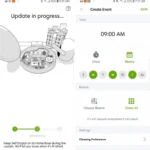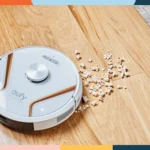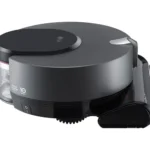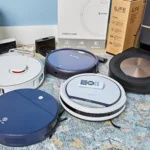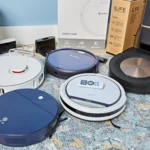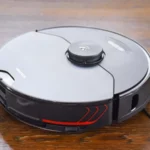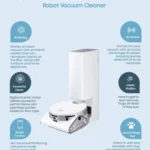Are you tired of constantly sweeping and vacuuming your floors by hand? Do you want a smarter way to keep your home clean and tidy? Look no further than the world of smart vacuum cleaners with obstacle detection and avoidance features. But with so many options available, it can be difficult to know where to start your search. That’s why we’ve put together this comprehensive guide to help you choose the best vacuum for your needs. From budget and battery life to WiFi connectivity and voice assistant compatibility, we’ll take you through everything you need to consider before making your purchase. So sit back, relax, and let us help you navigate the exciting world of smart cleaning technology.
Obstacle Detection And Avoidance Features
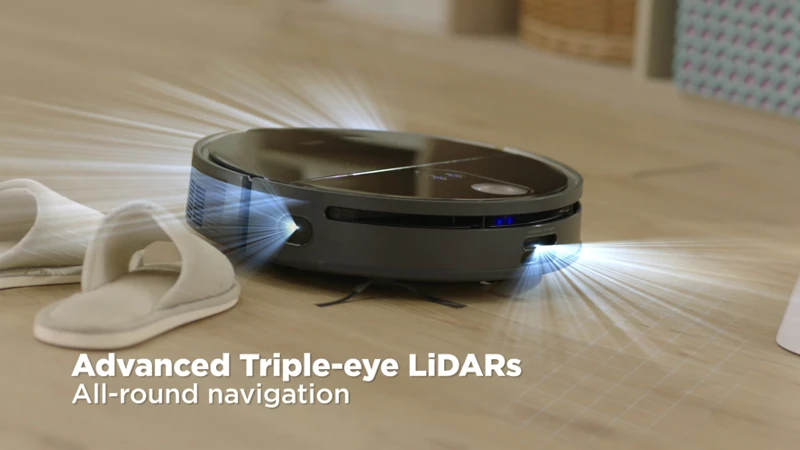
As smart vacuum cleaners become increasingly popular, obstacle detection and avoidance features are becoming a must-have function for those looking to purchase a new vacuum. These features not only ensure that the vacuum can navigate around any obstacles in its path with ease, but they also help to protect the furniture and walls in your home from any potential damage. In this section, we’ll dive deeper into what obstacle detection and avoidance is, how it works, and the many benefits it can bring to your cleaning routine. For more information about the topic, check out our article on obstacle detection and avoidance in smart vacuums.
What Is Obstacle Detection And Avoidance?
Obstacle detection and avoidance is a feature that comes with smart vacuum cleaners to keep them from getting stuck or causing any damage as they go about their cleaning tasks. It uses sensors to detect obstacles on its path and moves around them or alternatively stops and changes direction.
One of the common ways obstacle detection and avoidance works is through the use of infrared sensors that can detect objects in the vacuum’s path. These sensors send a signal to the vacuum cleaner’s central processor which will then decide on the best course of action based on the input data received from the sensors.
Some models also use laser sensors to create maps of the room, which can help the vacuum cleaner navigate around obstacles more effectively. This type of obstacle detection and avoidance is often used in conjunction with mapping technology to create an accurate floor plan of the room.
The benefits of obstacle detection and avoidance are many. These features are designed to ensure that the smart vacuum cleaner operates efficiently and effectively by effectively circumventing obstacles, preventing damage, and ultimately minimizing the need for human interaction.
Obstacle detection and avoidance technology is a critical feature to consider when choosing a smart vacuum cleaner. Not only does it help prevent damage to both the vacuum and the furniture, but it also ensures a much more effective, thorough cleaning experience. To explore further on this topic, check out this article on /top-5-smart-vacuum-cleaners-obstacle-detection/.
How Does Obstacle Detection And Avoidance Work?
Obstacle detection and avoidance technology in smart vacuum cleaners is designed to help these devices navigate around the home without bumping into objects or people. This technology typically uses a combination of sensors, cameras, and advanced algorithms and software to detect obstacles and plan the best way to get around them.
Sensors: Some smart vacuum cleaners use sensors like infrared sensors or laser range finders to detect objects in their path. These sensors emit a beam of light and measure the time it takes for the light to reflect back to the sensor. This allows the vacuum cleaner to determine how far away an object is and whether it needs to navigate around it.
Cameras: Other smart vacuum cleaners use cameras to detect objects in their path. These cameras can capture images of the surrounding environment and send them to the vacuum’s onboard computer. The computer then processes these images to determine the location of objects in the room and plan a route that avoids them.
Algorithms and software: Smart vacuum cleaners with obstacle detection and avoidance technology also use complex algorithms and software to plan their routes and avoid obstacles. These algorithms take into account factors like the size and shape of the room, the location of furniture and other objects, and the vacuum’s own movement capabilities.
The obstacle detection and avoidance technology in smart vacuum cleaners allows these devices to navigate around your home without getting stuck, bumping into walls or furniture, or falling down stairs. While this technology is not perfect and may still encounter some challenges, it has come a long way and is getting better with each new model of smart vacuum cleaner.
If you want to learn more about smart vacuum cleaners, visit our article on smart vacuum mapping navigation and obstacle detection. Or, if you’re interested in the future of obstacle detection technology in smart vacuums, you can read our article on the future of obstacle detection in smart vacuums. Additionally, if you’re experiencing some common problems with obstacle detection on your smart vacuum cleaner, head to our article on common problems with obstacle detection in smart vacuums for some solutions.
The Benefits Of Obstacle Detection And Avoidance Features
Smart vacuum cleaners with obstacle detection and avoidance features are becoming increasingly popular due to their numerous benefits. These features ensure that the vacuum cleaner moves around obstacles in the home, preventing it from getting stuck and promoting more efficient cleaning. Let’s take a look at some of the key benefits of obstacle detection and avoidance features in a table format:
| Benefits of Obstacle Detection and Avoidance Features |
| Prevents the vacuum cleaner from getting stuck on obstacles and furniture |
| Promotes more efficient and thorough cleaning by allowing the vacuum cleaner to navigate around your home |
| Reduces the risk of damage to your furniture and belongings by preventing collisions |
| Ensures that the vacuum cleaner can operate autonomously without the need for constant intervention and guidance |
| Saves time and effort by eliminating the need to manually move obstacles out of the vacuum’s path |
| Enhances the overall cleaning experience by providing a more seamless and stress-free operation |
Having obstacle detection and avoidance features on your smart vacuum cleaner can make a significant difference in the way you approach your cleaning routine. By preventing your vacuum cleaner from getting stuck and allowing it to navigate around your home autonomously, you can save time, effort, and potentially costly repairs to your furniture by minimizing the risk of collisions. Additionally, these features provide a more seamless and stress-free cleaning experience, allowing you to focus on other tasks while your smart vacuum cleaner does the work.
Things To Consider When Choosing A Smart Vacuum Cleaner With Obstacle Detection And Avoidance Features
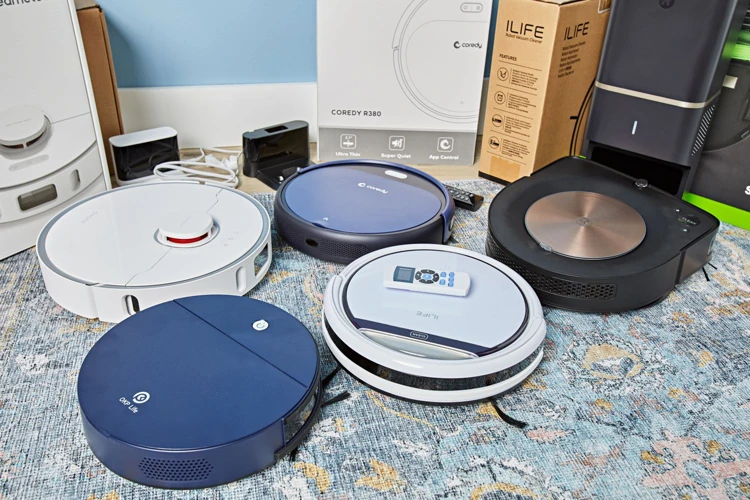
When choosing a smart vacuum cleaner with obstacle detection and avoidance features, there are a variety of factors to consider. From budget to battery life, mapping technology to WiFi connectivity, the options can quickly become overwhelming. However, by breaking down each consideration and understanding how they affect the overall functionality of the vacuum cleaner, you can make an informed decision about which one will best suit your needs. In this section, we will discuss the most important things to consider before making your purchase.
Budget
When it comes to choosing a smart vacuum cleaner with obstacle detection and avoidance features, one of the essential factors to consider is your budget. These intelligent devices come with different price tags depending on their features and specifications. Here is a breakdown of what to expect at different price points:
| Budget Range | Features |
|---|---|
| Low-end: | Typically priced under $200, you can expect basic obstacle detection and avoidance features, such as random mapping and simple onboard sensors. These models may not have WiFi connectivity and app features. |
| Mid-range: | Smart vacuum cleaners in this range are priced between $200 and $500. They offer better obstacle detection and avoidance features, including more advanced mapping technology, improved sensors, and longer battery life. You may also find models with WiFi connectivity and app features. |
| High-end: | Priced above $500, high-end smart vacuum cleaners come with top-of-the-line features, such as laser-guided mapping, advanced obstacle detection and avoidance, longer battery life, WiFi connectivity, and an intuitive app interface. These models also tend to be more durable and reliable. |
Keep in mind that while budget is a significant factor in choosing a smart vacuum cleaner with obstacle detection and avoidance features, it should not be the only consideration. It would help if you also considered other features such as mapping technology, battery life and charging time, dustbin capacity, filtration system, brush types and performance, WiFi connectivity and app features, size and weight, noise level, and compatibility with voice assistants. By considering all these factors, you can select a smart vacuum cleaner that fits both your budget and your cleaning needs.
Mapping Technology
When choosing a smart vacuum cleaner with obstacle detection and avoidance features, mapping technology is a crucial consideration. Mapping technology allows the vacuum cleaner to intelligently navigate your home and avoid obstacles such as furniture and walls. Here are some important things to consider when evaluating mapping technology:
- Accuracy: The accuracy of the mapping technology is a critical factor to consider. The more accurate the mapping, the better the vacuum cleaner will be at avoiding obstacles and cleaning efficiently. Look for vacuum cleaners that use advanced sensors, cameras and laser technology for optimal mapping accuracy.
- Real-time Mapping: Real-time mapping is a feature that allows the vacuum cleaner to create a map of your home as it goes. This is the most effective way to ensure that the vacuum cleaner navigates your home accurately and avoids obstacles. Real-time mapping also allows the vacuum cleaner to create a virtual map of your home, which you can view on the companion app to keep track of cleaning progress.
- Memory: When considering mapping technology, it’s important to check the vacuum cleaner’s memory capacity. Some vacuum cleaners have limited memory, which means they may forget the layout of your home if they are interrupted, such as if you pick them up and move them to a different room. Look for vacuum cleaners with enough memory to remember the layout of your entire home.
- Obstacle Detection: Another important aspect of mapping technology is obstacle detection. The vacuum cleaner should be able to detect obstacles in real-time and avoid them. Some vacuum cleaners use advanced sensors and algorithms to detect obstacles, while others rely on basic sensors. Make sure you choose a vacuum cleaner with advanced obstacle detection capabilities.
The mapping technology is a critical aspect of a smart vacuum cleaner with obstacle detection and avoidance features. By choosing a vacuum cleaner with accurate real-time mapping, ample memory, advanced obstacle detection, and real-time mapping, you can ensure that you get the best cleaning performance and keep your home tidy without any hassles.
Battery Life And Charging Time
One of the most important factors to consider when choosing a smart vacuum cleaner with obstacle detection and avoidance features is battery life and charging time. Here are some key points to keep in mind:
- Battery Life: Look for a vacuum cleaner with a long battery life, preferably over 120 minutes, especially if you have a large home. This will ensure that it can clean multiple rooms without needing a recharge.
- Charging Time: Consider the time it takes for the vacuum cleaner to fully charge. Some models take only a few hours to recharge, while others may take up to 5 hours. If the charging time is lengthy, it may be inconvenient to have the vacuum cleaner charging for that amount of time before use.
- Battery Type: Check if the vacuum cleaner uses a lithium-ion battery, which is long-lasting and quick to recharge. Avoid models with nickel-cadmium batteries if possible since they don’t last as long and have a charge memory.
- Battery Indicator: Look for a vacuum cleaner with a battery level indicator. This will let you know when it’s time to recharge the vacuum cleaner.
- Auto Recharge Feature: Consider models that have an auto-recharge feature. This feature allows the vacuum cleaner to return to its charging station when its battery gets low, ensuring that it’s always ready for its next use.
Battery life and charging time are essential factors to think about when selecting a smart vacuum cleaner with obstacle detection and avoidance features. Choosing a model with a long battery life, short charging time, and an auto-recharge feature will ensure that the vacuum cleaner can clean your home thoroughly and efficiently without any unnecessary interruptions.
Dustbin Capacity
When it comes to choosing a smart vacuum cleaner with obstacle detection and avoidance features, dustbin capacity is an essential factor to consider. This determines the amount of dirt and debris the vacuum can collect before needing to be emptied.
A larger dustbin capacity means that the vacuum will be able to clean for longer periods before needing to be emptied. This can be particularly helpful for larger homes, where the vacuum may need to clean multiple rooms before needing to be emptied.
On the other hand, if you have a smaller home or don’t produce a lot of debris, a smaller dustbin capacity may be sufficient. It’s also worth noting that a smaller dustbin can make the vacuum more lightweight and manageable, which is important for those who have difficulty moving heavy objects.
When comparing different models, it’s important to look beyond the advertised dustbin capacity. Some models have higher advertised capacities but may not be as efficient at collecting debris, meaning you’ll need to empty the bin more frequently.
To help you compare different models, the following table compares the dustbin capacity, filter type, and weight of three popular smart vacuums on the market:
| Model | Dustbin Capacity | Filter Type | Weight |
|---|---|---|---|
| Vacuum A | 0.5 liters | HEPA | 4.1 kg |
| Vacuum B | 0.6 liters | Standard | 3.7 kg |
| Vacuum C | 0.8 liters | HEPA | 5.2 kg |
As you can see, there is variation in dustbin capacity, filter type, and weight. Choosing the right dustbin capacity for your needs is just one of the many considerations to keep in mind when selecting a smart vacuum cleaner with obstacle detection and avoidance features.
Filtration System
When considering a smart vacuum cleaner with obstacle detection and avoidance features, the filtration system is an important factor to take into account. A good filtration system ensures that the air in your home is clean and free of dust, allergens, and other harmful particles. In this section, we will look at some of the factors you should consider when choosing a smart vacuum cleaner based on its filtration system.
One of the primary things to look for is the type of filter used by the vacuum cleaner. Most smart vacuum cleaners come with high-efficiency particulate air (HEPA) filters. These filters are designed to trap tiny particles as small as 0.3 microns, making them ideal for those who suffer from allergies or breathing issues. Another type of filter you can consider is the ultraviolet (UV) filter. These filters use UV-C light to kill germs, bacteria, and viruses.
To make it easy for you to compare different smart vacuum cleaners based on their filtration systems, we have created a table highlighting some of the key features to consider:
| Filter Type | Efficiency | Replacement Cost |
|---|---|---|
| HEPA | Traps particles as small as 0.3 microns | Usually more expensive, but lasts longer |
| UV | Kills germs, bacteria, and viruses | Usually cheaper, but needs to be replaced more frequently |
While the type of filter is important, you should also consider how many filters the smart vacuum cleaner has. Some models have multiple filters, including pre-filters and post-filters, which help to prolong the life of the HEPA or UV filters. This means you won’t have to replace the main filter as frequently, saving you money in the long run.
Another factor to consider is the filtration efficiency of the vacuum cleaner. This is usually expressed as a percentage and refers to the percentage of particles the filter is able to capture. The higher the percentage, the better the filtration efficiency. Look for a vacuum cleaner with a filtration efficiency of at least 99%, which means it is able to capture almost all of the particles in your home.
Finally, consider the ease of maintenance of the filtration system. Choose a vacuum cleaner with filters that are easy to remove and clean, and that don’t require special tools or equipment to replace. This will make it easier for you to maintain the cleanliness of the vacuum cleaner and ensure its longevity.
By taking these factors into consideration when choosing a smart vacuum cleaner, you can ensure that your home is clean and healthy, and that your vacuum cleaner is efficient and easy to maintain.
Brush Types And Performance
When choosing a smart vacuum cleaner with obstacle detection and avoidance features, it’s important to consider the type of brush and its performance. The brush is responsible for picking up dirt, dust, and other debris from various surfaces, so you want to make sure it is effective.
Here are some brush types and performance factors to consider:
- Bristles: Look for a vacuum cleaner with a brush that has both soft and firm bristles. Soft bristles can help prevent scratches on delicate surfaces like hardwood floors, while firmer bristles are better for getting deep into carpets.
- Roller: Some vacuum cleaners come with a roller brush that is designed to pick up pet hair and other debris from carpets. Make sure the roller brush is easy to remove for cleaning and maintenance.
- Suction power: The vacuum’s suction power is also an important factor to consider when it comes to brush performance. A more powerful motor can provide stronger suction, quickly picking up debris while the brush agitates it from the surface.
- Adjustable height: A vacuum with an adjustable brush height can help ensure that it maintains consistent contact with different types of flooring. This helps to optimize cleaning performance and prevent damage by avoiding excessive pressure on the floor.
Choose a vacuum cleaner with a brush that can effectively clean your home. Be sure to consider the bristles, roller, suction power, and adjustable height. With the right brush, your smart vacuum cleaner can help you achieve cleaner floors with minimal effort.
WiFi Connectivity And App Features
When it comes to smart vacuum cleaners with obstacle detection and avoidance features, WiFi connectivity and app features can be a game-changer. With WiFi connectivity, you can control your vacuum cleaner using your smartphone, and with the app features, you can schedule cleaning times, set no-go zones, and much more. Here are some factors to consider when choosing a smart vacuum cleaner based on WiFi connectivity and app features:
| Factor | Description |
|---|---|
| Compatibility with Voice Assistants | Some smart vacuum cleaners come with voice assistant compatibility, allowing you to control them using voice commands through Google Assistant or Amazon Alexa. This feature can be particularly useful if you have mobility issues or if you want a hands-free cleaning experience. |
| App Features | Check if the smart vacuum cleaner comes with an app that has features such as scheduling, no-go zones, and cleaning history. These features can allow you to have more control over your cleaning routine and enable you to customize the cleaning experience based on your preferences. |
| WiFi Connectivity | Most smart vacuum cleaners come with WiFi connectivity, but it’s always worth checking to ensure that the cleaner is compatible with your home network. Additionally, make sure that the cleaner can maintain a stable connection as a weak WiFi signal can result in the cleaner getting stuck or losing its route. |
| Remote Control | Some smart vacuum cleaners come with a remote control, allowing you to operate the cleaner even if you’re not at home. This feature can be particularly useful if you want to schedule cleaning sessions while you’re away or if you want to see the cleaning progress in real-time while you’re at work. |
| Notifications | Check if the app sends notifications to your phone, such as when the cleaner’s battery is low or when the dustbin needs to be emptied. These notifications can help you keep track of the cleaner’s maintenance needs and ensure that it’s always functioning correctly. |
WiFi connectivity and app features can significantly enhance your cleaning experience by allowing you to schedule cleaning sessions, customize the cleaning routine, and control the cleaner. When choosing a smart vacuum cleaner based on these features, consider compatibility with voice assistants, app features, WiFi connectivity, remote control, and notifications. By taking these factors into account, you can find a smart vacuum cleaner that meets your needs and preferences.
Size And Weight
When it comes to choosing a smart vacuum cleaner with obstacle detection and avoidance features, size and weight are important factors to consider. A larger size may mean the vacuum has a larger dustbin capacity or longer battery life, but it could also mean it has difficulty navigating smaller spaces. Meanwhile, a lighter weight may make it easier to carry the vacuum around or store it, but it may also sacrifice some cleaning power.
To help you choose the right size and weight for your needs, we’ve created a table comparing some popular models:
| Model | Size (inches) | Weight (lbs) |
|---|---|---|
| iRobot Roomba i7+ | 13.34 x 13.34 x 3.63 | 7.44 |
| Shark IQ Robot Vacuum | 12.9 x 12.6 x 3.5 | 5.87 |
| Eufy BoostIQ RoboVac 11S | 12.8 x 12.8 x 2.85 | 5.73 |
| Ecovacs Deebot N79S | 12.9 x 12.9 x 3.07 | 6.7 |
| iLife V3s Pro | 11.8 x 11.8 x 3 | 4.5 |
As you can see, the iRobot Roomba i7+ is one of the heaviest models, weighing in at 7.44 lbs. However, it also has the largest dustbin capacity and longest battery life out of the models listed. On the other end of the spectrum, the iLife V3s Pro is the lightest model, weighing only 4.5 lbs, but it may not have as much cleaning power.
Ultimately, the choice of size and weight will depend on your personal preferences and cleaning needs. If you have a larger home or more carpeted areas, a larger and heavier vacuum may be the better option. If you have a smaller living space or need to carry the vacuum up and down stairs, a lighter and more compact model may be the way to go.
Noise Level
When choosing a smart vacuum cleaner with obstacle detection and avoidance features, it’s important to consider the noise level produced by the device. A noisy vacuum can be disruptive to daily activities, especially in smaller living spaces or during late-night cleaning sessions.
Noise Level
The noise level of a vacuum cleaner is measured in decibels (dB). The lower the dB rating, the quieter the vacuum cleaner will be. Generally, a vacuum cleaner with a noise level below 70 dB is considered quiet, while those above 80 dB are considered loud.
Here are some common noise levels for reference:
| Noise Level | Description |
|---|---|
| Less than 60 dB | Equivalent to a normal conversation |
| 60-70 dB | Quiet and unobtrusive |
| 70-80 dB | Loud, but tolerable for short periods of time |
| Above 80 dB | Very loud and disruptive |
If noise levels are a concern, it’s important to look for vacuum cleaners that specifically advertise their quietness. Some brands may also use sound-dampening materials or use technology to reduce vacuum noise.
Keep in mind that the noise level may also vary depending on the type of surface the vacuum is cleaning, with carpets and rugs usually being louder than hard floors.
The noise level of a smart vacuum cleaner with obstacle detection and avoidance features is an important consideration when choosing the best vacuum for you and your home.
Compatibility With Voice Assistants
In this day and age, we’re all looking for ways to make our lives easier, and thanks to voice assistants, we can control our smart home devices with just our voices. This is why the compatibility of a smart vacuum cleaner with voice assistants is an important feature to consider when making a purchase decision.
What Is Voice Assistant Compatibility?
Voice assistant compatibility refers to the ability of a smart vacuum cleaner to integrate with popular voice assistants such as Amazon Alexa and Google Assistant. It allows you to control your vacuum cleaner using simple voice commands.
Benefits Of Voice Assistant Compatibility
The biggest benefit of voice assistant compatibility is convenience. Imagine being able to start your cleaning cycle or navigate your vacuum cleaner to a specific area without ever having to pick up your phone or use the vacuum’s remote control.
Voice assistant compatibility brings hands-free cleaning to a new level of efficiency. You can schedule cleaning sessions, check the status of your vacuum cleaner, and even receive alerts when the dustbin is full or when the battery is running low.
Table Of Compatible Devices
Here’s a table that showcases some of the popular voice assistants that are compatible with certain models of smart vacuum cleaners:
| Smart Vacuum Cleaner | Voice Assistant Compatibility |
|---|---|
| iRobot Roomba i7+ | Amazon Alexa, Google Assistant, Siri |
| Eufy RoboVac 11S Max | Amazon Alexa, Google Assistant |
| Neato Botvac D7 Connected | Amazon Alexa, Google Assistant |
| Xiaomi Mi Robot Vacuum | Amazon Alexa, Google Assistant |
| Shark AI Robot Vacuum | Amazon Alexa |
How To Set Up Voice Assistant Compatibility
Setting up voice assistant compatibility is a simple process that usually involves:
1. Connecting your vacuum cleaner to your WiFi network through the manufacturer’s app.
2. Enabling the skill or action for your preferred voice assistant, according to the instructions provided by the manufacturer.
3. Linking your vacuum cleaner account with your voice assistant account.
4. Using simple voice commands to control your smart vacuum cleaner.
Conclusion
Voice assistant compatibility is a feature that adds a great deal of convenience to your smart home experience. By allowing you to control your vacuum cleaner with just your voice, you can save time and effort, and focus on the more important things in life. When considering a smart vacuum cleaner with obstacle detection and avoidance features, make sure you check for compatibility with your preferred voice assistant.
Maintaining Your Smart Vacuum Cleaner
Ensuring that your smart vacuum cleaner is well-maintained is essential for its efficient and effective operation. Neglecting regular maintenance can result in reduced cleaning performance, increased noise levels, and premature wear and tear on the device. It is crucial to follow a proper maintenance routine to keep your device in top condition. In this section, we will discuss the various aspects of maintaining your smart vacuum cleaner to ensure that it continues to function optimally.
Cleaning The Dustbin And Filter
When it comes to maintaining your smart vacuum cleaner with obstacle detection and avoidance features, one of the most important tasks is cleaning the dustbin and filter. This ensures that your vacuum cleaner continues to function properly and effectively removes dirt and debris from your home.
Why Cleaning the Dustbin and Filter is Important
Over time, dust, hair, and other debris can accumulate in the dustbin and filter of your vacuum cleaner. This buildup can lead to reduced suction power and cause your vacuum cleaner to work less efficiently. It can also cause unpleasant odors and decrease the lifespan of your machine.
Cleaning the Dustbin and Filter
To clean the dustbin and filter, follow these steps:
| Step | Description |
|---|---|
| Step 1 | Turn off the vacuum cleaner |
| Step 2 | Empty the dustbin into a trash can |
| Step 3 | Remove the filter from the dustbin |
| Step 4 | Tap the filter on a hard surface to remove any loose debris |
| Step 5 | Wash the filter under running water until it is clean |
| Step 6 | Dry the filter completely before reinserting it into the dustbin |
| Step 7 | Reinsert the filter into the dustbin and secure it in place |
How Often Should You Clean the Dustbin and Filter?
The frequency of cleaning your dustbin and filter will depend on how often you use your smart vacuum cleaner and how much dirt and debris it picks up. As a general rule, it is recommended to clean the dustbin and filter after every use. This ensures that your vacuum cleaner is always ready for its next cleaning task.
Cleaning the dustbin and filter is a crucial part of maintaining your smart vacuum cleaner with obstacle detection and avoidance features. By following the steps outlined above and cleaning the dustbin and filter regularly, you can optimize the performance and lifespan of your machine.
Cleaning The Brushes
When it comes to maintaining your smart vacuum cleaner, cleaning the brushes regularly is essential to keep it running smoothly and effectively. Over time, the brushes can become tangled with pet hair and debris, which can impact its ability to clean. Here are some tips on how to clean your smart vacuum cleaner’s brushes:
Schedule regular brush cleanings
The frequency of brush cleanings will depend on how often you use your smart vacuum cleaner and how much debris and pet hair it picks up. As a general rule, it’s a good idea to clean the brushes every two weeks. However, you may need to clean them more frequently if you have pets that shed a lot or if you use the vacuum cleaner in high-traffic areas.
Gather your cleaning supplies
Before you begin cleaning the brushes, make sure you have all the necessary supplies on hand. You’ll need a pair of scissors, a soft cloth, and a cleaning solution. You can use a mild soap or a cleaning solution specifically designed for smart vacuum cleaner brushes.
Remove the brushes from the vacuum cleaner
Refer to your smart vacuum cleaner’s manual for instructions on how to remove the brushes. For most models, you will need to turn the vacuum cleaner over and remove the brush assembly cover to access the brushes. Once the brushes are exposed, gently lift them out of the vacuum cleaner.
Clean the brushes
Use scissors to carefully cut away any hair or debris that may be tangled around the brushes. Be sure to only cut the hair and not the brushes themselves. After removing the majority of the hair, use a soft cloth dipped in cleaning solution to wipe away any remaining debris.
Reinstall the brushes
Once you have finished cleaning the brushes, carefully reinsert them back into the vacuum cleaner. Make sure they are properly aligned and securely attached.
Test the brushes
Turn on your smart vacuum cleaner and test the brushes to ensure they are spinning properly. If the brushes are still not spinning properly, check to make sure they are installed correctly or consult the manual for further troubleshooting.
By regularly cleaning the brushes and following these simple steps, you can ensure that your smart vacuum cleaner stays in top shape and continues to provide optimal cleaning performance.
Checking For Firmware Updates
Checking for firmware updates is an important aspect of keeping your smart vacuum cleaner running smoothly. Firmware updates are software updates that the manufacturer releases to improve the performance or fix any bugs or glitches. It’s important to check for and install these updates to ensure that your vacuum is operating at its best.
Why Should You Check For Firmware Updates?
Firmware updates can bring significant improvements to your smart vacuum cleaner, including better obstacle detection and avoidance, improved battery performance, and more efficient mapping. They can also fix any bugs or issues that may be affecting the vacuum’s performance. It’s crucial to check for firmware updates and install them as soon as they become available.
How To Check For Firmware Updates?
Most smart vacuum cleaners come with a mobile app that allows you to control the vacuum and check for firmware updates. The app will indicate whether an update is available and provide instructions on how to install it. Additionally, you can check for updates manually by visiting the manufacturer’s website and searching for firmware updates for your specific model.
When To Check For Firmware Updates?
Manufacturers release firmware updates periodically, and it’s essential to check for updates regularly to ensure that your vacuum is always up to date. You can set a reminder in your calendar to check for updates every three months, or you can enable automatic updates if your vacuum cleaner supports it.
What To Do Before Installing Firmware Updates?
Before installing firmware updates, make sure that your vacuum cleaner is fully charged and connected to a stable Wi-Fi network. Ensure that you have read the update instructions carefully and that you understand them before proceeding with the installation. If you have any questions, contact the manufacturer’s customer support for assistance.
Conclusion
Checking for firmware updates is crucial to keeping your smart vacuum cleaner running efficiently. By regularly updating your vacuum’s firmware, you can ensure that it performs optimally and avoid any potential issues or bugs. Remember to check for firmware updates regularly, and always follow the update instructions carefully to avoid any problems.
Replacing Parts
Smart vacuum cleaners with obstacle detection and avoidance features are fantastic tools that can make cleaning your home much easier and more convenient. However, like any other household appliance, they require regular maintenance to ensure that they continue to function at their best. One essential aspect of maintaining the longevity of your smart vacuum cleaner is replacing parts when needed.
Here are some parts that you may need to replace:
- Battery: If you notice that your smart vacuum cleaner does not hold a charge as well as it used to, or if it dies very quickly after being fully charged, it may be time to replace the battery. Make sure to purchase the correct replacement battery for your model, and follow the manufacturer’s instructions for installation.
- Filter: Over time, the filter of your smart vacuum cleaner can become clogged with dirt and debris, which can affect the efficiency of the vacuum’s suction. It is recommended to replace the filter every three to six months or as recommended by the manufacturer. Refer to the user manual or online instructions for guidance on installing a new filter.
- Brushes: The brushes on your smart vacuum cleaner are designed to pick up dirt and debris, but they can also become tangled or worn down over time. If you notice that the brushes are not turning as well as they used to or if they have excessive wear or damage, it may be time to replace them. Refer to the user manual for guidance on removing and replacing the brushes.
- Wheels: Smart vacuum cleaners with obstacle detection and avoidance features can move around your home quite frequently, and this can put wear and tear on the wheels over time. If you notice that the wheels are not moving as smoothly as they should or that they are making strange noises, it may be time to replace them.
- Charging Dock: The charging dock is what your smart vacuum cleaner uses to recharge its battery. If you notice any damage or connectivity issues with the dock, it may be time to replace it. Replacement docks can usually be purchased directly from the manufacturer or from third-party vendors.
Remember that replacing parts on your smart vacuum cleaner can help to extend its lifespan and keep it functioning at its best. If you are unsure about how to replace any of these parts, refer to the user manual or contact the manufacturer for further guidance.
Conclusion
In conclusion, choosing a smart vacuum cleaner with obstacle detection and avoidance features can greatly simplify your cleaning routine and improve the cleanliness of your home. By considering the factors discussed above, such as budget, mapping technology, battery life, dustbin capacity, filtration system, brush types and performance, WiFi connectivity, size and weight, noise level, and compatibility with voice assistants, you can make an informed decision that best suits your needs and preferences.
Moreover, it’s important to remember that maintaining your smart vacuum cleaner is crucial to its longevity and performance. Regularly cleaning the dustbin and filter, as well as the brushes, and checking for firmware updates, will ensure that your device operates optimally.
With the advanced technologies available in today’s market, a smart vacuum cleaner with obstacle detection and avoidance features can offer a degree of convenience and efficiency that traditional vacuum cleaners cannot. From avoiding obstacles to mapping your home and functioning through voice assistants, these devices are designed to simplify your life.
Overall, whether you have a strict budget or are willing to invest in a high-end device, there is a smart vacuum cleaner with obstacle detection and avoidance features to suit your needs. Keep these factors in mind when making your purchase, and enjoy a cleaner, smarter home with your new device.
Frequently Asked Questions
1. Can I use a smart vacuum cleaner with obstacle detection and avoidance features in a large home?
Yes, many smart vacuum cleaners are designed for large homes and can cover large areas on a single charge. Just make sure to choose a model with a long battery life or docking station for automatic charging.
2. Do I need to have WiFi for my smart vacuum cleaner to work?
Most smart vacuum cleaners require WiFi for full functionality, including app control and voice assistant compatibility. However, some models may still work autonomously without WiFi.
3. Can a smart vacuum cleaner with obstacle detection and avoidance features clean on multiple surfaces?
Yes, many models have brush types and suction power settings that are adjustable according to the type of flooring or surface being cleaned.
4. How often should I clean the dustbin and filter of my smart vacuum cleaner?
You should clean the dustbin and filter after each use to maintain efficient suction and to prevent clogging. Some models also have self-cleaning features for the dustbin and filter.
5. Does a smart vacuum cleaner with obstacle detection and avoidance features work on stairs?
No, most smart vacuum cleaners are not designed to navigate stairs and can be dangerous if they fall down. They typically have sensors that prevent them from going too close to the edge of a step.
6. Do I need to replace the brushes on my smart vacuum cleaner?
Yes, the brushes on a smart vacuum cleaner can wear out over time and should be replaced periodically for optimal performance.
7. How much noise does a smart vacuum cleaner with obstacle detection and avoidance features make?
The noise level of a smart vacuum cleaner can vary depending on the model and settings, but most are designed to operate quietly to avoid disturbing household activities.
8. What is the benefit of voice assistant compatibility?
Voice assistant compatibility allows you to control your smart vacuum cleaner hands-free and can save time and effort. You can also set cleaning schedules and receive status updates through voice commands.
9. Can a smart vacuum cleaner with obstacle detection and avoidance features clean under furniture?
Yes, many models have a low profile and are designed to clean under furniture and along edges and corners. Some also have side brushes for improved coverage.
10. How do I check for firmware updates on my smart vacuum cleaner?
You can usually check for firmware updates through the manufacturer’s app or website. Some models may also have automatic update notifications or be able to update themselves when they are charging.

